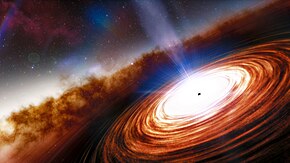| QSO J0313−1806 | |
|---|---|
 Artist's impression of quasar J0313–1806 showing the supermassive black hole and the extremely high velocity wind Artist's impression of quasar J0313–1806 showing the supermassive black hole and the extremely high velocity wind | |
| Observation data (Epoch J2000.0) | |
| Constellation | Eridanus |
| Right ascension | 03 13 43.84 |
| Declination | −18° 06′ 36.4″ |
| Redshift | 7.6423±0.0013 |
| Distance | 13 billion ly (4.0 billion pc) (light travel distance) 30 billion ly (9 billion pc) (proper distance) |
| See also: Quasar, List of quasars | |
QSO J0313−1806 was the most distant, and hence also the oldest known quasar at z = 7.64, at the time of its discovery. In January 2021, it was identified as the most redshifted (highest z) known quasar, with the oldest known supermassive black hole (SMBH) at (1.6±0.4)×10 solar masses. The 2021 announcement paper described it as "the most massive SMBH at z > 7". This quasar beat the prior recordsetting quasar, ULAS J1342+0928. In 2023, UHZ1 was discovered, setting a new record for most distant quasar, eclipsing that of QSO J0313−1806.
One of the 2021 paper authors, Feige Wang, said that the existence of a supermassive black hole so early in the existence of the Universe posed problems for the current theories of formation since "black holes created by the very first massive stars could not have grown this large in only a few hundred million years". The redshift z = 7.642 corresponds to an age of about 600 million years.
See also
- Direct collapse black hole, a process by which black holes may form less than a few hundred million years after the Big Bang
- List of the most distant astronomical objects
- List of quasars
- PSO J172.3556+18.7734
- ULAS J1342+0928
References
- ^ Wang et al. 2021.
- "QSO J0313-1806". SIMBAD. Centre de données astronomiques de Strasbourg. Retrieved 20 April 2023.
- Temming, Maria (January 18, 2021), "The most ancient supermassive black hole is bafflingly big", Science News, vol. 199, no. 3, Washington, D.C.: Society for Science & the Public, p. 4, retrieved February 28, 2021
- ^ Tasoff, Harrison (January 19, 2021), "Researchers discover the earliest supermassive black hole and quasar in the universe", phys.org, retrieved February 28, 2021
- Wang F, Yang J, Fan X, Hennawi J, Barth A (January 12, 2021), "238.01. A Luminous Quasar at a Redshift of z=7.64", American Astronomical Society 237th Meeting, retrieved February 28, 2021
- Wang et al. 2021, p. 4.
- Michelle Starr (13 January 2021). "Astronomers have discovered the earliest known supermassive black hole at the center of an ancient, faraway galaxy". Business Insider. ScienceAlert.
- Cosmin Ilie, Katherine Freese, Andreea Petric, Jillian Paulin (21 December 2023), UHZ1 and the other three most distant quasars observed: possible evidence for Supermassive Dark Stars, arXiv:2312.13837
{{citation}}: CS1 maint: multiple names: authors list (link)
Sources
- Wang, Feige; Yang, Jinyi; Fan, Xiaohui; Hennawi, Joseph F.; Barth, Aaron J.; Banados, Eduardo; Bian, Fuyan; Boutsia, Konstantina; Connor, Thomas; Davies, Frederick B.; Decarli, Roberto; Eilers, Anna-Christina; Farina, Emanuele Paolo; Green, Richard; Jiang, Linhua; Li, Jiang-Tao; Mazzucchelli, Chiara; Nanni, Riccardo; Schindler, Jan-Torge; Venemans, Bram; Walter, Fabian; Wu, Xue-Bing; Yue, Minghao (2021). "A Luminous Quasar at Redshift 7.642". The Astrophysical Journal. 907 (1): L1. arXiv:2101.03179. Bibcode:2021ApJ...907L...1W. doi:10.3847/2041-8213/abd8c6. S2CID 231572944.
Further reading
- Alec Fox (January 19, 2021), "This 13-Billion-Year-Old Supermassive Black Hole Is the Oldest Ever Found", Smithsonian
| Records | ||
|---|---|---|
| Preceded byULAS J1342+0928 | Most distant known quasar 2021 – 2023 |
Succeeded byUHZ1 |
This quasar-related article is a stub. You can help Misplaced Pages by expanding it. |


